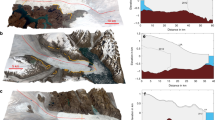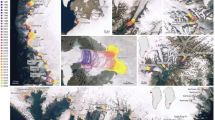Abstract
Glaciers and ice caps (GICs) are important contributors to present-day global mean sea level rise1,2,3,4. Most previous global mass balance estimates for GICs rely on extrapolation of sparse mass balance measurements1,2,4 representing only a small fraction of the GIC area, leaving their overall contribution to sea level rise unclear. Here we show that GICs, excluding the Greenland and Antarctic peripheral GICs, lost mass at a rate of 148 ± 30 Gt yr−1 from January 2003 to December 2010, contributing 0.41 ± 0.08 mm yr−1 to sea level rise. Our results are based on a global, simultaneous inversion of monthly GRACE-derived satellite gravity fields, from which we calculate the mass change over all ice-covered regions greater in area than 100 km2. The GIC rate for 2003–2010 is about 30 per cent smaller than the previous mass balance estimate that most closely matches our study period2. The high mountains of Asia, in particular, show a mass loss of only 4 ± 20 Gt yr−1 for 2003–2010, compared with 47–55 Gt yr−1 in previously published estimates2,5. For completeness, we also estimate that the Greenland and Antarctic ice sheets, including their peripheral GICs, contributed 1.06 ± 0.19 mm yr−1 to sea level rise over the same time period. The total contribution to sea level rise from all ice-covered regions is thus 1.48 ± 0.26 mm −1, which agrees well with independent estimates of sea level rise originating from land ice loss and other terrestrial sources6.
This is a preview of subscription content, access via your institution
Access options
Subscribe to this journal
Receive 51 print issues and online access
$199.00 per year
only $3.90 per issue
Buy this article
- Purchase on Springer Link
- Instant access to full article PDF
Prices may be subject to local taxes which are calculated during checkout


Similar content being viewed by others
References
Cogley, J. G. Geodetic and direct mass-balance measurements: comparison and joint analysis. Ann. Glaciol. 50, 96–100 (2009)
Dyurgerov, M. B. Reanalysis of glacier changes: from the IGY to the IPY, 1960–2008. Data Glaciol. Stud. 108, 1–116 (2010)
Hock, R., de Woul, M., Radic, V. & Dyurgerov, M. Mountain glaciers and ice caps around Antarctica make a large sea-level rise contribution. Geophys. Res. Lett. 36, L07501 (2009)
Meier, M. F. et al. Glaciers dominate eustatic sea-level rise in the 21st century. Science 317, 1064–1067 (2007)
Matsuo, K. & Heki, K. Time-variable ice loss in Asian high mountains from satellite gravimetry. Earth Planet. Sci. Lett. 290, 30–36 (2010)
Willis, J. K., Chambers, D. P., Kuo, C. Y. & Shum, C. K. Global sea level rise, recent progress and challenges for the decade to come. Oceanography (Wash. DC) 23, 26–35 (2010)
Hirabayashi, Y., Doll, P. & Kanae, S. Global-scale modeling of glacier mass balances for water resources assessments: glacier mass changes between 1948 and 2006. J. Hydrol. (Amst.) 390, 245–256 (2010)
Kaser, G., Cogley, J. G., Dyurgerov, M. B., Meier, M. F. & Ohmura, A. Mass balance of glaciers and ice caps: consensus estimates for 1961–2004. Geophys. Res. Lett. 33, L19501 (2006)
Tapley, B. D., Bettadpur, S., Watkins, M. & Reigber, C. The gravity recovery and climate experiment: mission overview and early results. Geophys. Res. Lett. 31, L09607 (2004)
Wahr, J., Swenson, S., Zlotnicki, V. & Velicogna, I. Time-variable gravity from GRACE: first results. Geophys. Res. Lett. 31, L11501 (2004)
Chen, J. L., Wilson, C. R., Tapley, B. D., Blankenship, D. D. & Ivins, E. R. Patagonia icefield melting observed by gravity recovery and climate experiment (GRACE). Geophys. Res. Lett. 34, L22501 (2007)
Gardner, A. S. et al. Sharply increased mass loss from glaciers and ice caps in the Canadian Arctic Archipelago. Nature 473, 357–360 (2011)
Luthcke, S. B., Arendt, A. A., Rowlands, D. D., McCarthy, J. J. & Larsen, C. F. Recent glacier mass changes in the Gulf of Alaska region from GRACE mascon solutions. J. Glaciol. 54, 767–777 (2008)
Riva, R. E. M., Bamber, J. L., Lavallee, D. A. & Wouters, B. Sea-level fingerprint of continental water and ice mass change from GRACE. Geophys. Res. Lett. 37, L19605 (2010)
Rignot, E., Velicogna, I., van den Broeke, M. R., Monaghan, A. & Lenaerts, J. Acceleration of the contribution of the Greenland and Antarctic ice sheets to sea level rise. Geophys. Res. Lett. 38, L05503 (2011)
Tiwari, V. M., Wahr, J. & Swenson, S. Dwindling groundwater resources in northern India, from satellite gravity observations. Geophys. Res. Lett. 36, L18401 (2009)
Raup, B. H., Kieffer, H. H., Hare, J. M. & Kargel, J. S. Generation of data acquisition requests for the ASTER satellite instrument for monitoring a globally distributed target: glaciers. IEEE Trans. Geosci. Remote Sens. 38, 1105–1112 (2000)
Brown, J., Ferrians, O. J., Heginbottom, J. A. & Melnikov, E. S. Circum-Arctic Map of Permafrost and Ground-Ice Conditions. National Snow and Ice Data Center/World Data Center for Glaciology (1998, revised, February 2001)
Velicogna, I. Increasing rates of ice mass loss from the Greenland and Antarctic ice sheets revealed by GRACE. Geophys. Res. Lett. 36, L19503 (2009)
Cogley, J. G. in Future Climates of the World (eds Henderson-Sellers, A. & McGuffie, K. ) 189–214 (Elsevier, 2012)
Rodell, M., Velicogna, I. & Famiglietti, J. S. Satellite-based estimates of groundwater depletion in India. Nature 460, 999–1002 (2009)
Bettinelli, P. et al. Plate motion of India and interseismic strain in the Nepal Himalaya from GPS and DORIS measurements. J. Geod. 80, 567–589 (2006)
Jackson, M. & Bilham, R. Constraints on Himalayan deformation inferred from vertical velocity-fields in Nepal and Tibet. J. Geophys. Res. Solid Earth 99, 13897–13912 (1994)
Zhong, S. J. & Zuber, M. T. Crustal compensation during mountain-building. Geophys. Res. Lett. 27, 3009–3012 (2000)
Lemoine, F. et al. The Development of the Joint NASA GSFC and NIMA Geopotential Model EGM96. NASA Goddard Space Flight Center. (1998)
Cheng, M. K. & Tapley, B. D. Variations in the Earth’s oblateness during the past 28 years. J. Geophys. Res. 109, B09402 (2004)
Swenson, S., Chambers, D. & Wahr, J. Estimating geocenter variations from a combination of GRACE and ocean model output. J. Geophys. Res. Solid Earth 113, B08410 (2008)
Rowlands, D. D. et al. Resolving mass flux at high spatial and temporal resolution using GRACE intersatellite measurements. Geophys. Res. Lett. 32, L04310 (2005)
Ivins, E. R. & James, T. S. Bedrock response to Llanquihue Holocene and present-day glaciation in southernmost South America. Geophys. Res. Lett. 31, L24613 (2004)
Acknowledgements
We thank Geruo A for providing the glacial isostatic adjustment model, and G. Cogley, G. Kaser, I. Velicogna, T. Perron and M. Tamisiea for comments. This work was partially supported by NASA grants NNX08AF02G and NNXI0AR66G, and by NASA’s ‘Making Earth Science Data Records for Use in Research Environments (MEaSUREs) Program’.
Author information
Authors and Affiliations
Contributions
T.J. and J.W. developed the study and wrote the paper. W.T.P. and S.S. discussed, commented on and improved the manuscript. S.S. provided the CLM4 hydrology model output.
Corresponding author
Ethics declarations
Competing interests
The authors declare no competing financial interests.
Supplementary information
Supplementary Information
This file contains Supplementary Methods, additional references, Supplementary Figures 1-6 with legends and Supplementary Tables 1-2. (PDF 1193 kb)
Rights and permissions
About this article
Cite this article
Jacob, T., Wahr, J., Pfeffer, W. et al. Recent contributions of glaciers and ice caps to sea level rise. Nature 482, 514–518 (2012). https://doi.org/10.1038/nature10847
Received:
Accepted:
Published:
Issue Date:
DOI: https://doi.org/10.1038/nature10847
This article is cited by
-
Abating water storage and associated hydrological processes in Indian Himalayan river basins
Theoretical and Applied Climatology (2024)
-
The evolving landscape of sea-level rise science from 1990 to 2021
Communications Earth & Environment (2023)
-
Oceanic climate changes threaten the sustainability of Asia’s water tower
Nature (2023)
-
Evolution of drought and flood events on the Qinghai-Tibet Plateau and key issues for response
Science China Earth Sciences (2023)
-
Groundwater sustainability assessment in the Middle East using GRACE/GRACE-FO data
Hydrogeology Journal (2023)
Comments
By submitting a comment you agree to abide by our Terms and Community Guidelines. If you find something abusive or that does not comply with our terms or guidelines please flag it as inappropriate.




